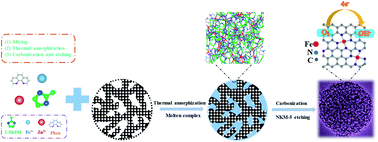A general approach for hierarchically porous metal/N/C nanosphere electrocatalysts: nano-confined pyrolysis of in situ-formed amorphous metal–ligand complexes†
Abstract
A nano-confined pyrolysis approach was developed for constructing highly nitrogen-doped hierarchically porous metal/N/C nanospheres (typically Fe/N/C-HP). Hierarchically porous silica nanospheres (NKM-5) were used as a hard template, and an amorphous Fe/Zn-(MeIm)2 complex was employed as a carbon and nitrogen source. During the pyrolysis process, first, the molten Fe/Zn-(MeIm)2 complex diffused into hierarchically porous tunnels of NKM-5. Secondly, the interface confinement effect of nanopores in NKM-5 could effectively immobilize nitrogen to coordinate with iron atom, prevent the aggregation of Fe-based species and form single-atom Fe sites. After the silica template was removed, the catalyst exhibited a hierarchically porous structure and uniform spherical morphology. This hierarchically porous structure of Fe/N/C-HP can enhance mass transport/electron transfer and greatly improve the accessibility of Fe/N/C sites. As a result, the Fe/N/C-HP catalyst exhibits excellent oxygen reduction performance with a half-wave potential (E1/2) of 0.90 V in alkaline media and 0.78 V in acidic media. A primary Zn–air battery with Fe/N/C-HP as the cathode catalyst exhibits a large peak power density of 181 mW cm−2 and discharge stability. This nano-confined pyrolysis of amorphous M/Zn-(MeIm)2 complex is a general method to construct a hierarchically porous M/N/C (M = Fe, Co, Cu, Mn and Ni) electrocatalyst with well-defined morphology.



 Please wait while we load your content...
Please wait while we load your content...